- Products
-
Design Templates
- Featured Design Galleries
- More Galleries
- Services & Resources
- Free Sample Kit
- Deals

Online printing is fast becoming the printing method of choice among U.S. businesses. It's convenient, fast, and cheaper in cost to the brick and mortar print shop across town. However, not all online printing companies are created equal. The best online printing companies have websites that guide you through the printing preparation as well as consultants available for customer service. The following details some of the basic principles that will help you get the best online printing result.
Image quality and format
Today's lithograph and digital presses work at higher resolutions than in days past, which means images of a lower resolution will have to be “stretched.” Furthermore, don't confuse size with resolution. Resolution is a measure of dots per inch (dpi) an image contains; the higher the dpi, the greater the detail and clarity. If you submit an image at 96 dpi for example, a modern press may have to increase it to 300 dpi by adding “white” dots between the spaces. The result is a fuzzy and low-color image. Any graphic images you upload should be a minimum 300 dpi. The format for saving your images should be TIF or EPS. Even though the most popular file formats for graphics are JPEG, PNG and GIF, those formats are compressed. When the files are uncompressed for printing, resolution is lost. On the other hand, TIF and EPS files are not compressed. The only downside is that TIF and EPS files are rather large. Upload them using high-speed Internet if you can.
Image color
Sometimes customers will upload their completed jobs for printing only to find out that the colors of the finished product do not look the same as they did on their computer screen. This is because most computer monitors display color in three phases: red, green and blue (RGB). Printing presses, however, utilize four colors: cyan, magenta, yellow and black (CMYK). If you convert your image to CMYK within your graphic design program, you'll get more accurate rendition of what the finished product will look like – but keep in mind that your computer screen will still only display it in RGB.
Photographs and scanned images
Photographs and scanned images almost always print darker on paper than they appear on a computer screen. The reason for this goes back to resolution and how the press interprets the image. When using photographs or scanned images, lighten them by 15 percent to 20 percent before saving them for upload – especially for black and white photos. The images may look terrible on your screen, but they will be just fine on the printed page.
Get a hardcopy proof
The single most important step you can take when it comes to ensuring the best online printing is to request a hardcopy proof. This way you can hold your finished product in-hand to inspect for any mistakes or surprises before you approve the final print job. Consider the minimal fee an investment in insurance that could potentially save you hundreds or even thousands of dollars.